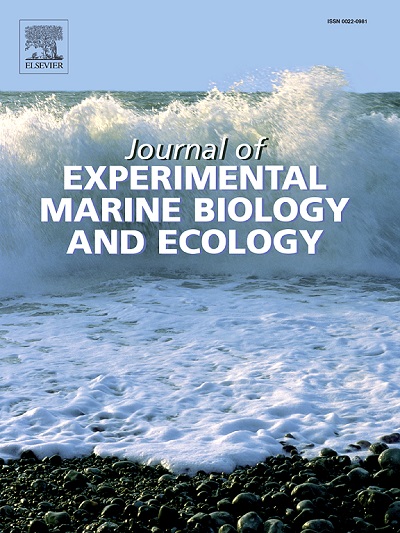大藻和同种藻是绿唇贻贝幼体在不同发育阶段的重要附着基质
IF 1.8
3区 生物学
Q3 ECOLOGY
Journal of Experimental Marine Biology and Ecology
Pub Date : 2025-05-17
DOI:10.1016/j.jembe.2025.152108
引用次数: 0
摘要
近几十年来,全球都在努力恢复贝类珊瑚礁及其提供的一系列生态系统服务,但这些努力遇到了许多挑战,其中最常见的是栖息地退化导致的基质限制和种群减少导致的幼虫缺乏补充。新西兰绿唇贻贝(Perna canaliculus)珊瑚礁的恢复也同样受到了移植到海底的人工养殖成年贻贝种群缺乏自然补充的阻碍。为了更全面地了解支持管状贝幼鱼在贻贝礁上发育的整个过程中所需要的基质,本研究在Hauraki湾的一个残余潮间带贻贝礁的不同微生境和潮间带内,在不同基质类型上存在不同大小类别的幼贻贝。在整个珊瑚礁中,5毫米壳长(SL)的早期幼鱼在同种(37%)和大型藻类(33%)上出现的频率相似,但5 - 10毫米SL的幼鱼在同种(64%)上出现的频率几乎是大型藻类(34%)的两倍。与此同时,≥10 mm SL的所有较大类别的幼鱼较少出现在大型藻类上(平均4%),最常出现在同种藻类上(平均27%),其次是裸露的岩石和壳(平均11%)。这些发现表明,大型藻类是小管假单胞藻幼体发育早期的关键附着基质,而同种基质在幼体发育后期支持幼体的建立,岩石和贝壳的支持能力较弱。此外,对于新兴岩石微生境中5 mm SL的早期幼鱼来说,它们在潮间带上游的大藻类上的存在比在潮间带上游的同种藻类上的存在高31%,而在潮间带下游的同种藻类上的存在比大藻类高28%,这表明在经历不同水平的水动力、种内竞争和捕食的珊瑚礁内不同位置的幼鱼基质关联是不同的。这项研究为微管蚌的早期生活史提供了有价值的见解,可以告知贻贝礁恢复从业者的底物类型;1)可能在恢复地点受到限制,2)如果在近距离应用,可能对促进恢复地点的招募最有效,以允许幼鱼在个体发育过程中在基质之间过渡,3)可以作为未来地点的选择标准,以及一组环境参数。本文章由计算机程序翻译,如有差异,请以英文原文为准。
Macroalgae and conspecifics serve as critical attachment substrates for juvenile green-lipped mussels (Perna canaliculus) during different stages of development
In recent decades, there has been a global push to restore shellfish reefs and the array of ecosystem services they provide, but these efforts are met with many challenges, the most common of which are substrate limitation due to habitat degradation and a lack of larval recruitment due to population declines. The restoration of green-lipped mussel (Perna canaliculus) reefs in New Zealand is similarly impeded by a lack of natural recruitment into populations of cultured adults that have been transplanted to the seafloor. To obtain a more complete understanding of the substrates needed to support the attachment of P. canaliculus juveniles throughout their development on mussel reefs, this study characterised the presence of different size classes of juvenile mussels on various substrate types within different microhabitats and intertidal zones on a remnant, intertidal mussel reef in the Hauraki Gulf. Across the reef, early juvenile P. canaliculus <5 mm in shell length (SL) were present on conspecifics (37 %) and macroalgae (33 %) with similar frequency, but juveniles 5 – <10 mm SL were present on conspecifics (64 %) almost twice as often as on macroalgae (34 %). Meanwhile, juveniles in all larger size classes ≥10 mm SL were present less often on macroalgae (average 4 %) and most often on conspecifics (average 27 %), followed by bare rock and shell for juveniles ≥20 mm SL (average 11 %). These findings indicate that macroalgae serves as a critical attachment substrate for juvenile P. canaliculus during early development, while conspecific substrate supports the establishment of juveniles throughout later development, alongside rock and shell in a lesser capacity. Additionally, for early juveniles <5 mm SL in emergent rock microhabitats, their presence was 31 % higher on macroalgae than on conspecifics in the upper intertidal but 28 % higher on conspecifics compared to macroalgae in the lower intertidal, indicating that juvenile substrate associations vary between locations within the reef that experience different levels of hydrodynamic force, intraspecific competition, and predation. This study offers valuable insights into the early life history of P. canaliculus that can inform mussel reef restoration practitioners of the types of substrates that; 1) may be limited at restoration sites, 2) are likely to be most effective for facilitating recruitment at restoration sites if applied in close proximity to allow juveniles to transition between substrates during ontogeny, and 3) can be used as a selection criteria for future sites, alongside a set of environmental parameters.
求助全文
通过发布文献求助,成功后即可免费获取论文全文。
去求助
来源期刊
CiteScore
4.30
自引率
0.00%
发文量
98
审稿时长
14 weeks
期刊介绍:
The Journal of Experimental Marine Biology and Ecology provides a forum for experimental ecological research on marine organisms in relation to their environment. Topic areas include studies that focus on biochemistry, physiology, behavior, genetics, and ecological theory. The main emphasis of the Journal lies in hypothesis driven experimental work, both from the laboratory and the field. Natural experiments or descriptive studies that elucidate fundamental ecological processes are welcome. Submissions should have a broad ecological framework beyond the specific study organism or geographic region.
Short communications that highlight emerging issues and exciting discoveries within five printed pages will receive a rapid turnaround. Papers describing important new analytical, computational, experimental and theoretical techniques and methods are encouraged and will be highlighted as Methodological Advances. We welcome proposals for Review Papers synthesizing a specific field within marine ecology. Finally, the journal aims to publish Special Issues at regular intervals synthesizing a particular field of marine science. All printed papers undergo a peer review process before being accepted and will receive a first decision within three months.

 求助内容:
求助内容: 应助结果提醒方式:
应助结果提醒方式:


